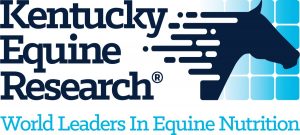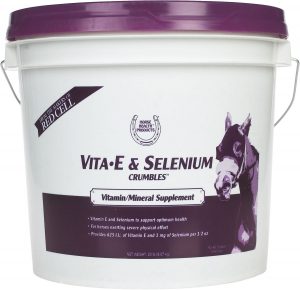 Once again, Kentucky Equine Research is guilty of misleading the horse-owning public with another “research” article, thinly veiled as a supplement sales pitch.
Once again, Kentucky Equine Research is guilty of misleading the horse-owning public with another “research” article, thinly veiled as a supplement sales pitch.
Yes, those quotation marks are intentional. Moreover, we might suggest KER rebrand itself as KERDS, Kentucky Equine Research Dedicated to Sales.
Earlier this year, we called out KER for the egregious headline “Radios Cause Gastric Ulcers” and the associated article that suggested turning off the radio, not letting horses live together and out of stalls, would mitigate ulcer concerns.
Read more about science gone sideways here.
In this article, “Possible Link Between Selenium and Cribbing Horses,” KER reported that researchers had found decreased levels of selenium in horses with that stereotypy. To solve that, KER nutritionist Kathleen Crandell states:
 “Micronutrient imbalances can affect many physiological processes, which is one reason why KER nutrition advisors are available for free consultation. They can help with feed analysis, recommend ration fortifiers containing vitamins and minerals, and antioxidants such as Nano-E, a water-soluble, natural-source of vitamin E.”
“Micronutrient imbalances can affect many physiological processes, which is one reason why KER nutrition advisors are available for free consultation. They can help with feed analysis, recommend ration fortifiers containing vitamins and minerals, and antioxidants such as Nano-E, a water-soluble, natural-source of vitamin E.”
We took a look at the research, led by a team in Iran. Yes, Iran! Just 20 horses (10 cribbers and 10 non-cribbers) were assessed. Yes, just 10 cribbers assessed! All the horses were kept in single stalls and most were stallions. Read the research here.
Yes, blood tests did indicate that cribbers had lower selenium levels. But, in fact, all 20 horses had selenium levels below recommended levels. And, get this: cribbers had lower cortisol levels than non-cribbers, a result not mentioned in the paper’s abstract nor in the KER post. Cortisol is the hormone associated with stress.
We take issue with the myopathy of the study and KER’s interpretation of it. Selenium and Vitamin E supplements are indeed recommended when pasture or hay lacks these nutrients. This Maryland study of over 200 horses found that most had adequate selenium levels.
But anyway, the Kentucky company message was as subtle as a brick to the head:
 Quick, all owners of cribbing horses! Order your horses not one but three suggested supplements.
Quick, all owners of cribbing horses! Order your horses not one but three suggested supplements.
Here’s what we DO know about cribbing:
- It is most often the result of poor management practices, like keeping a horse stalled, isolated, and/or giving it grain, and
- Once a cribbing horse, always a cribbing horse. Supplements won’t change that.
- Cribbers are not more susceptible to digestive problems. Aside from marking up fences and stalls with their incisors and wearing down their incisors prematurely, nothing terrible will come from cribbing.
- As this review of cribbing research stated: “Increasing opportunities for horses to engage in natural foraging and social behavior is probably the best approach in attempting to prevent the development of crib-biting behavior and shows some promise for reducing frequency and duration of the behavior in established cribbers.”
To their credit, in the article’s last paragraph, KER mentions better management as a possible strategy to reduce cribbing. But from this reader’s perspective, it felt more like a weak disclaimer, a bit like SmartPak’s campaign for its own supplements. To paraphrase this Massachusetts company:
Yes, we acknowledge that letting horses move, be part of a herd, and eat just hay and/or grass is probably best, but you, dear customer, wouldn’t want to do that. Feel better about what you do for your horse by spending money on our supplements, blankets, and tack.
‘Cuz spending money always makes us feel as if we were better, more loving horse owners.
Please.
Ugh, it’s frustrating as folks, in a high majority, just want to do what’s best for their horse. Articles like the Kentucky Research are muddying the waters, to the detriment of good horse care.
Despite the big money behind the horse world as a whole, ethical research methods aimed at improving the care and feeding of our equines seem entirely absent. For about the last 40 years nearly every new manufactured feed or supplement has looked more like a monetized castoff from another industrial process than actual nutrition. How can we be so gullible?
I have been researching selenium as a supplement and thinking of adding more to my horses’ diets. I am in south-central Wisconsin. I see that some “experts” suggest 5000mg/500 lbs. of body weight. There are no available supplement mixes that provide that much, so I’m considering ordering selenium oxide separately and feeding it. Anyone else with more knowledge than I have on this issue – please advise!?
Thanks for your comment, Edie. One has to be careful not to feed too much selenium. Here’s one article that might be helpful https://thehorse.com/129317/selenium-a-balancing-act/
Selenium has a relatively narrow margin of safety, as nutritional supplements go. The average Se requirement is 1 – 10mg/day for the average horse; more than this can be toxic. The concentrations you are suggesting (10 mg/lb of body weight, or 10,000 mg for an average horse) would be deadly. I suspect that your units are mistaken, and what you are suggesting may be 10ug/lb of body weight (5000ug/500lbs) would give you 10,000ug for an average 1000 lb horse per day, or 10 mg – still a whopping big dose that is likely toxic when added to what the horse is already getting from its forage. A microgram is .000001 gram or one part per million. South-Central WI appears to have adequate soil selenium levels (see: https://mrdata.usgs.gov/geochem/doc/averages/se/usa.html) , so if that is where your horse’s ration is coming from, there is likely not a problem with deficiency.
Some years back, I found the KER site thru a recommendation. I was not impressed. It appeared that they mostly wanted to sell their expensive supplements. More recently, I looked at their site again and felt that way even more strongly. So what you have to say here is not a surprise to me.
Thanks for this. It’s helpful to understand marketing vs research and articles like this clarify information for horse owners who are often exploited financially with inaccurate, misleading
information. Deception stops when when science comes in.
Interesting article. We live in New Zealand and we do not have selenium in our soils, so we have to give our horses minute amounts once a month. I purchased a new horse 3 weeks ago and she is an ex trotter race horse, who wind sucks. Very common in racehorses as they are boxed/stabled for long periods. She wind sucks on anything she can. I have been giving her copper sulphate in her feeds ( 1/4 teaspoon twice a day). I have been observing her when she does it and noticed when she came she just about did it all the time. Now she has settled in with the herd not so much. They have 18acres to roam on, so be interested to see how she gets on.